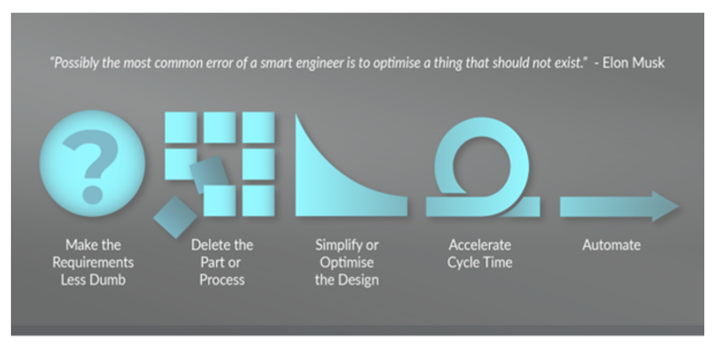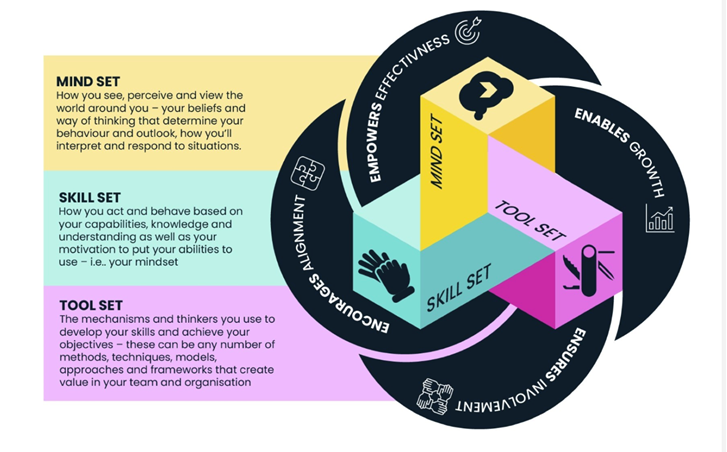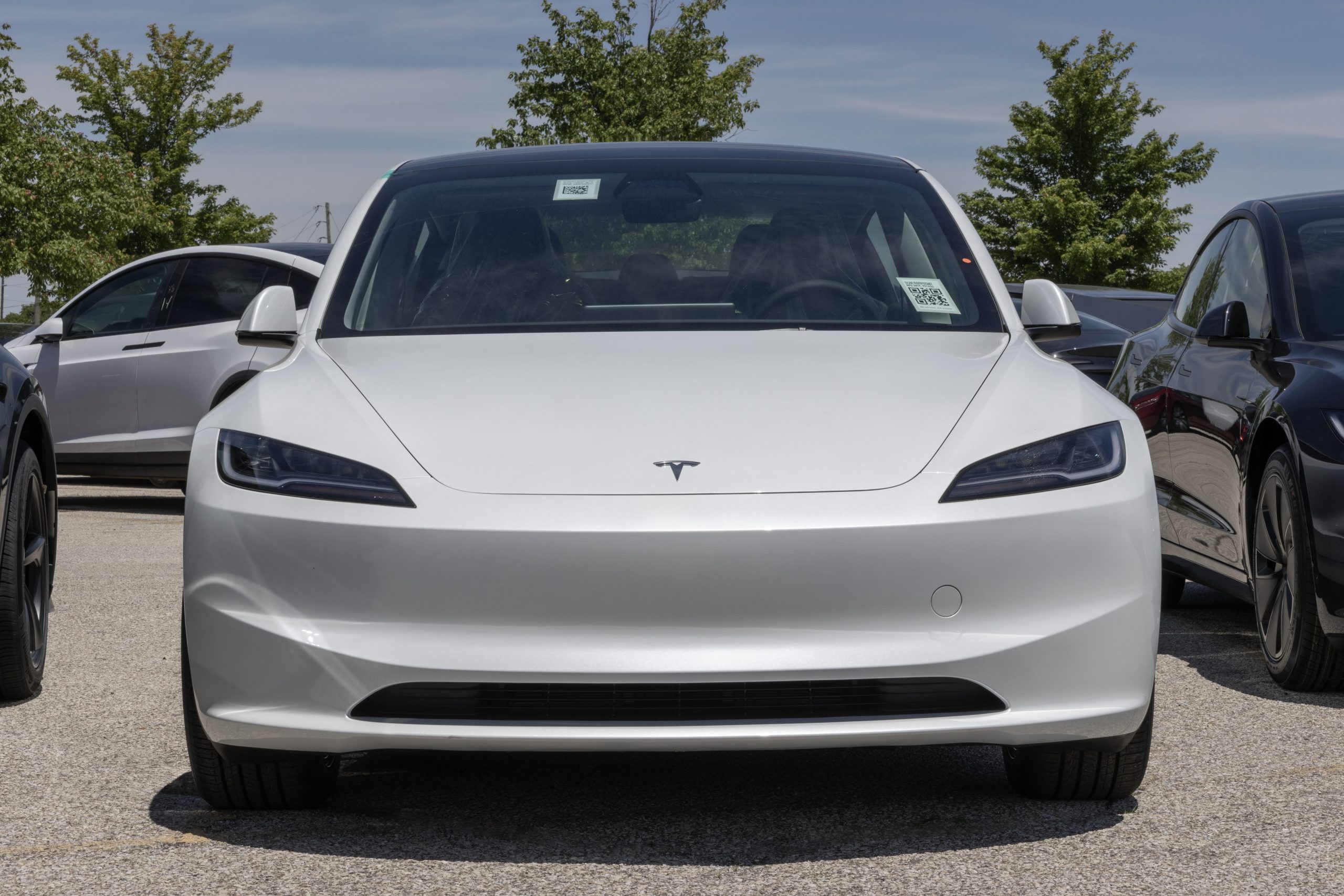Musk’s 5 Steps to Cut Internal Bureaucracy at Tesla and SpaceX, you may say it’s his Algorithm…
Feature | 08 - 12 - 2025
I’ve been reading Walter Isaacson’s biography of Elon Musk. It’s an interesting read, there are things not to like about Musk’s management approach for sure. There are, however, also some things we can all learn from his ways of work. For example, I like Musk’s algorithm reduces bureaucracy. I’m inspired by what Isaacson describes as Musk’s “algorithm”—his way of tirelessly busting internal bureaucracy and challenging complacency during production meetings at Tesla and SpaceX.

The 5 steps of Musk’s algorithm
Musk’s algorithm to bust bureaucracy at his production sites contains five main steps:
1. Question every requirement
Before changing anything in your processes, the first step of Musk’s algorithm is to create clarity about every requirement that exists today.
That clarity can be made by attaching a person—and a name—to every requirement. That is, each requirement should come with the name of the person who made that requirement.
Musk says; “You should never accept that a requirement came from a department, such as from ‘the legal department’ or ‘the safety department.’ You need to know the name of the real person who made that requirement.”
Once that clarity is achieved—that is, when every requirement has the person’s name attached—then you can start questioning whether these requirements make sense. No matter how smart or how ‘powerful’ that person is.
Musk: “Requirements from smart people are the most dangerous because people are less likely to question them. Always do so, even if the requirement came from me. Then make the requirements less dumb.”
Musk’s first step of his algorithm reminds me of the ICE “ABC” tool; A – Assume nothing, turn over all the stones and interrogate the detail. B – Be curious, ask yourself what it is I don’t understand here? and C – Confirm the important, what are we trying to deliver or achieve and what don’t we want.
2. Delete any part of the process you can
The second step of Musk’s algorithm is all about subtraction—a widely undervalued habit in management. In this case, it is all about deleting any part of the process you can.
In fact, it is all about deleting just a bit more than you feel comfortable with.
Musk: “You may have to add [parts or processes] back later. In fact, if you do not end up adding back at least 10% of them, then you didn’t delete enough.”
So often in client design work they find it so easy to add to a process or design and not to reduce or take away and simplify. This is a heuristic that is hard wired, people value losing things twice as much as adding or gaining, so when you think let’s get rid of this bit or the design or process, you have to work twice as hard to justify and commit to it, but it must be done.
Step one and two are the whole end to end process, then go to step 3.
3. Simplify and optimize
Only when you have walked through steps one and two can you start by simplifying and optimising (parts of) your processes.
The algorithm and the order of steps protects you from doing unnecessary work, it keeps you from improving (parts of processes) that you do not need in the end.
Musk: “A common mistake is to simplify and optimize a part or a process that should not exist.”
4. Accelerate cycle time
The fourth step of Musk’s algorithm is all about speed. It is about finding ways to speed up your bureaucratic processes. In our work with culture and performance, especially in the NHS, bureaucracy is cited as one of the biggest energy suckers for people and teams. If total energy available is 100% then this is often at 30-35% of total energy used, how much loss is that? This energy could be used for productive work!
“Every process can be speeded up,” says Musk. “But only do this after you have followed the first three steps. In the Tesla factory, I mistakenly spent a lot of time accelerating processes that I later realized should have been deleted.”
5. Automate
The fifth and last step of Musk’s algorithm involves automation. Now that you have clarity about your processes and have deleted any unnecessary parts to speed up your bureaucratic processes, the final step is to look for what you can potentially automate.
Musk: “[Automate] comes last. The big mistake in [my factories] was that I began by trying to automate every step. We should have waited until all the requirements had been questioned, parts and processes deleted, and the bugs were shaken out.”
Automation can be both decision making and mechanical and digital automation. In our current work to scale digital neighbourhoods across the Southwest of England, automation will be both about identifying people at risk, and supporting their decision-making, we have already identified where lack of clarity is on this. My decision will have a huge impact and can be automated. As for the AI tool that will help identify people who, with a different and earlier intervention, will lead more healthy and independent lives and the automation is remarkable.
There must be more?
Musk’s five-step process to bust internal bureaucracy sounds so simple, but the impact has clearly been huge. This impact, by the way, goes far beyond just applying the five steps in production settings, services will gain the same huge impact.
The steps are useful to keep repeating constantly in an entire organisation, and for that matter, systems as in ICS and their ICB’s. All should be wise to adopt them as an internal mantra for continual improvement.
Imagine how you can use these five steps to cut bureaucracy and increase effectiveness in all your organisational processes. Think about how internal processes, such as budgeting, procurement, recruitment, retention and work planning, and many more, could improve dramatically. The possibilities seem endless. Musk’s five-step process to bust internal bureaucracy and make work more productive sounds so simple, but the impact can be huge.

Musk’s other management heuristics
Aside from the five main steps, Isaacson describes several other heuristics Musk uses to organise work at his companies. These are the ones I personally liked:
For managers
“All technical managers must have hands-on experience. For example, managers of software teams must spend at least 20% of their time coding. I think this really applies to our work in the NHS, many of the managers I coach are committed to spending at least 20% Oof their time in patient care practising their professional skills. Otherwise, they are like a cavalry leader who can’t ride a horse, or a general who can’t use a sword.?”
About failure
“It’s OK to be wrong. Just don’t be confident and wrong.”
For your leadership
“Never ask your people to do something you’re not willing to do.”
Rules and guidelines
“The only rules are the ones dictated by the laws of physics. Everything else is a recommendation.”
Recruiting
“When hiring, recruit people with the right attitude and beliefs that align. Skills can be taught. Attitude and what people align to, like being honest, valuing hard work and that work is an important part of a whole life, without this you may require a brain transplant.”
Problem-solving
“Whenever there are problems to solve, don’t just meet with your managers. Do a skip level, where you meet with the right people that are at the front line as well as your managers.”

Beyond Musk ideology
Isaacson’s book was more than enough of Musk’s management heuristics. It’s time to return to my focus of truly human-centred design and for me and the team @ICE_Creates a more progressive human-centred methodology.
This article is distributed as part of our monthly Organisational Development Newsletter. Sign up here to join the growing community of leaders and change makers. If you would like to know more, we can share our resources with you.
Please contact marketing@icecreates.com.
Want to know more about Organisational Development or see how we have transformed cultures at the highest level?
Or check out Walter Isaacson’s biography of Elon Musk



